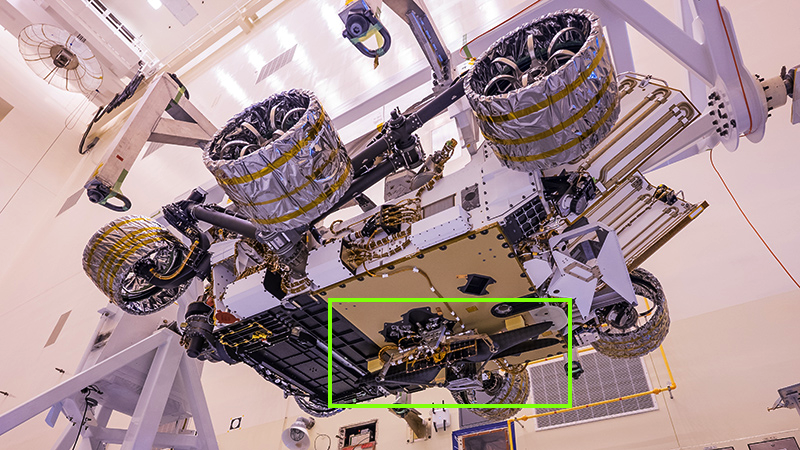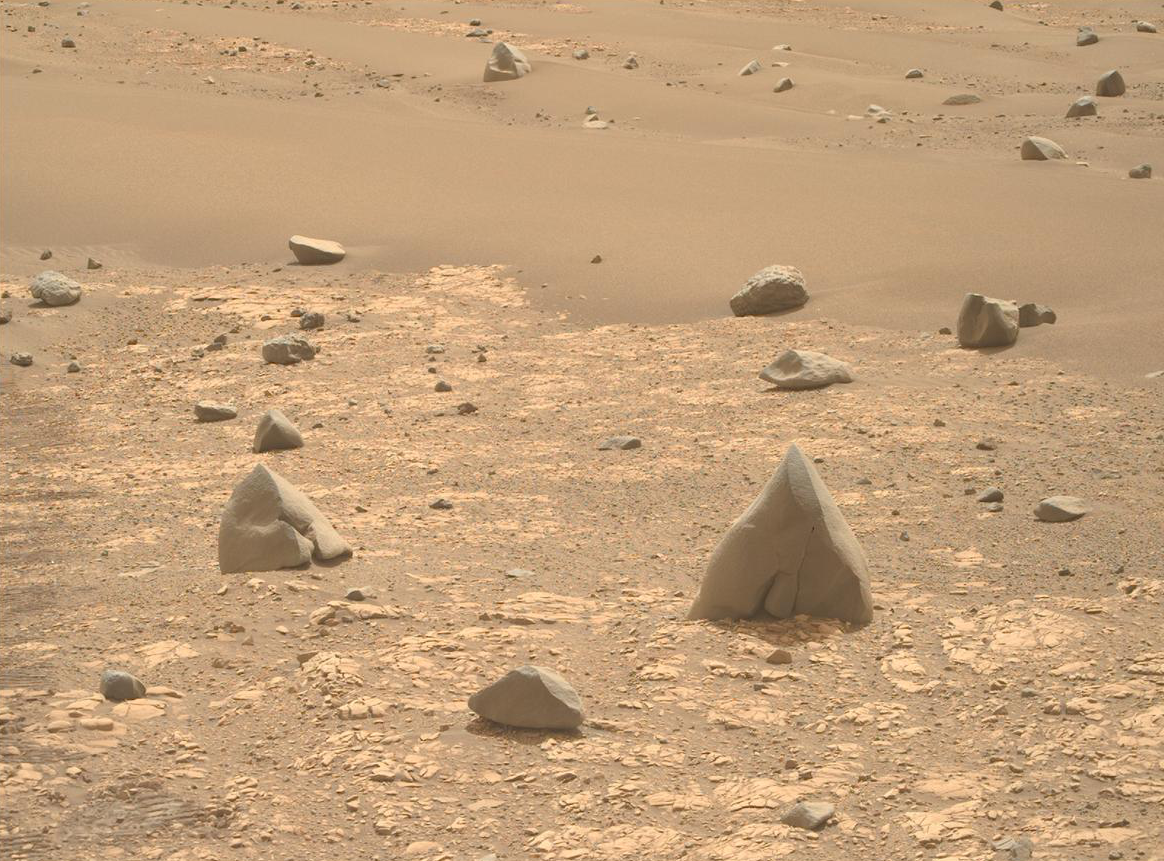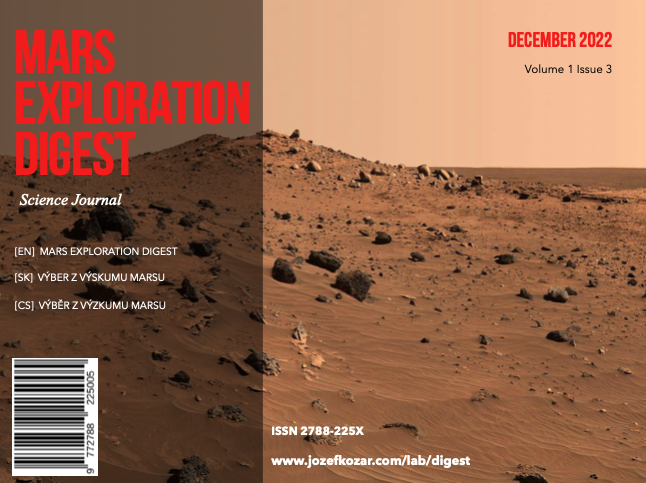Mars Exploration Digest: Issue December 2022
A regular monthly digest of Mars research news for December 2022. PDF: Issue 3, Volume 1, ISSN 2788-225X.
Tip:
[SK] Slovenskú verziu článku si môžte prečítať tu: Výber z výskumu Marsu: December 2022
–
View from Ingenuity flying above the surface
The Ingenuity robotic helicopter captured some exciting footage during its recent flight. One of them is this image he captured using his high-resolution dash cam. This camera is located in the fuselage of the helicopter and its lens is aimed approximately 22° below the horizon, therefore it enables the surface to be captured especially during the flight at exciting locations.

Image credit: NASA/JPL-Caltech.
The image was taken on December 10, 2022 (Sol 642 of the Perseverance’s mission at 16:31:59 local time LMST*). It was Ingenuity’s 36th flight since the start of the Perseverance mission to Mars.

Robotic helicopter Ingenuity at the bottom of the belly of Perseverance rover. Image credit: NASA/JPL-Caltech.
InSight’s mission has ended
The InSight’s mission ended after more than four years of collecting unique data and information that helped us get to know the interior of Mars in detail and the very internal dynamics of this planet.
InSight, short for “Interior Exploration using Seismic Investigations, Geodesy and Heat Transport”, was tasked with studying the deep interior of the planet Mars. The data obtained by the probe brought us details about the inner layers of Mars, the surprisingly strong remnants below the surface of its extinguished magnetic dynamo, as well as interesting information and detailed data about the weather in this part of Mars. Not to mention many shocks, the so-called marsquakes (the so-called marsquakes are a sign of surface tremors, just like there are earthquakes on Earth).
The Mission Control Center at JPL (Jet Propulsion Laboratory, Pasadena, California) failed to establish a successful data link with the InSight lander after two consecutive attempts. All analyzes lead to the same conclusion, which is the complete discharge of the onboard batteries, the charging of which depends on the probe’s solar cells.
Although the decision to end the mission of the probe by the NASA agency was set for the moment when it will not be possible to establish a direct connection with the probe twice in a row, the “listening” of the signal will continue just in case. However, at this point, it is more or less unlikely that any response will be recorded. The InSight spacecraft last communicated with Earth on December 15, 2022.
Mars is much more active than we thought until now
According to new studies, the interior of the planet Mars is much more active and dynamic than we thought until now.

An artist’s rendering of the active mantle, shows a chamber of hot molten rock rising from the planet’s interior. It gradually reaches the site of Elysium Planitia in the northern part of Mars. Image credit: Adrien Broquet & Audrey Lasbordes.
On Earth, shifting tectonic plates change the planet’s surface and create a dynamic interior. The absence of such processes on Mars has so far led us to believe that it is a dead planet, where basically not much has happened in the last 3 billion years. In the current issue of the journal Nature Astronomy, University of Arizona scientists challenge current views on the geodynamic evolution of Mars by reporting the discovery of an active mantle that pushes the surface upward, causing Martian earthquakes and volcanic eruptions. The published findings suggest that the apparently calm surface of the planet Mars probably hides its much more “tumultuous” interior than we have assumed so far.
Perseverance: an interesting picture

The image was acquired by the Perseverance rover at the Yori Pass location. Sol 615. Image credit: NASA/JPL-Caltech.
I decided to include this interesting image in the current December edition of Selection from Mars Research. It was taken by the Perseverance probe back on November 12, 2022, but the actual study and detailed analysis are still ongoing. Why is this image interesting to us? One of the main methods of examining the surface is precisely the visual identification of terrain elements, which tell us a lot of information by their color difference.
For example, dark rocks with sharp edges, found on bedrock with a completely different color and texture, tell us that they were not formed in this place. They were moved to this place by geological processes long ago. Also, the geological classification of these rocks will probably not be the same as the other elements forming the subsoil and the surrounding area. From these first analyzes alone, we have many other questions to which we will certainly find interesting answers.
Perseverance “breathes” carbon dioxide
The Perseverance probe has a unique device that, in layman’s terms, “breathes” the air on Mars and “exhales” oxygen. This is a MOXIE device.

MOXIE device (Mars Oxygen In-Situ Resource Utilization Experiment) just after physical installation inside the Perseverance rover. Image credit: NASA/JPL-Caltech.
The MOXIE device, which is about the size of a toaster, uses a high-temperature electrochemical process called “solid oxide electrolysis” to remove oxygen ions from carbon dioxide in the Martian atmosphere. The device has two small gas outlets: one through which the produced oxygen is discharged and the other through which a mixture of carbon monoxide and unreacted carbon dioxide exits. This device successfully demonstrates the method of producing oxygen in the atmospheric conditions of a planet other than Earth.
The sound of the dust devil on Mars
The Perseverance probe recorded the sound of a dust vortex (the so-called “Dust Devil” from the English “Dust Devil”).

Image credit: NASA/JPL-Caltech.
The Perseverance rover combination of instruments recently experienced the passage of the dust vortex in a somewhat new and more complex way. The microphone that is part of the SuperCam device recorded the sound of the dust devil, while the navigation camera took pictures and the environmental station (MEDA device) on board the probe measured the pressure drop when the dust vortex literally “passed” through the rover. The recording even captures the sound of dust grains hitting the probe itself. The results were published in a recent paper in Nature Communications.
You can listen to the sound below:
Curiosity and her gift to geologists
Just before Christmas, the Curiosity rover (MSL mission) prepared an interesting gift for geologists somewhat “unintentionally”. During its movement on the spot, it “rubbed away” a piece of the bedrock underneath, revealing white rocks with different compositions.

Image credit: NASA/JPL-Caltech.
As of these days, Curiosity has no planned activities involving activity with the help of a robotic arm and also no other movement, the analysis of this “gift” for geologists remains for the new year 2023.
News about the Mars Exploration Digest monthly digital magazine
After the first two months of its existence, the English version of the monthly magazine “Mars Exploration Digest” and its Slovak version “Výber z výskumu Marsu”, records an increasing interest from readers (both online and PDF versions). Therefore, the monthly magazine brings several changes and news:
- In the new year, 2O23, the electronic edition in PDF format will be converted to a single comprehensive format – from now on, both language versions will be in one comprehensive PDF file.
- Another novelty is the possibility to contribute with contributions from the ranks of those interested in Mars, students, or researchers.
- The magazine was assigned its own international registration number for periodicals in the Czech Republic: ISSN 2788-225X, which is gradually gaining more prestige.
The magazine itself will continue to be available for free at the end of each month.
In the coming time, some other news and enhancements will be added and these will enrich the content of the new editions.
PF 2023
To the New Year 2023, I wish all of you good health, because that is the most important thing. Also, I wish for an end to the senseless Russian war in Ukraine as soon as possible and an end to all other conflicts on our blue planet. I firmly believe that the economic crisis, which is the result of exaggerated “green” visions, combined with the consequences resulting from the necessary measures during the pandemic and with “the top on the cake”, which is the stupid Russian war and its consequences, will begin to fade as soon as possible. Take care folks, see you in 2023.
~ Jozef Kozár, PhD.
Mars Exploration Digest (PDF version): Issue 3, Volume 1, ISSN 2788-225X.
Tip:
[SK] Slovenskú verziu článku si môžte prečítať tu: Výber z výskumu Marsu: December 2022
Notes:
LMST – Local Mean Solar Time – Exact time on Mars in the location where the robotic mission is currently underway (solar time).
You can download this edition in PDF format for free here:

December 2022
Send download link to:
![]()
You can also find this article in the online version of the newspaper SME.









